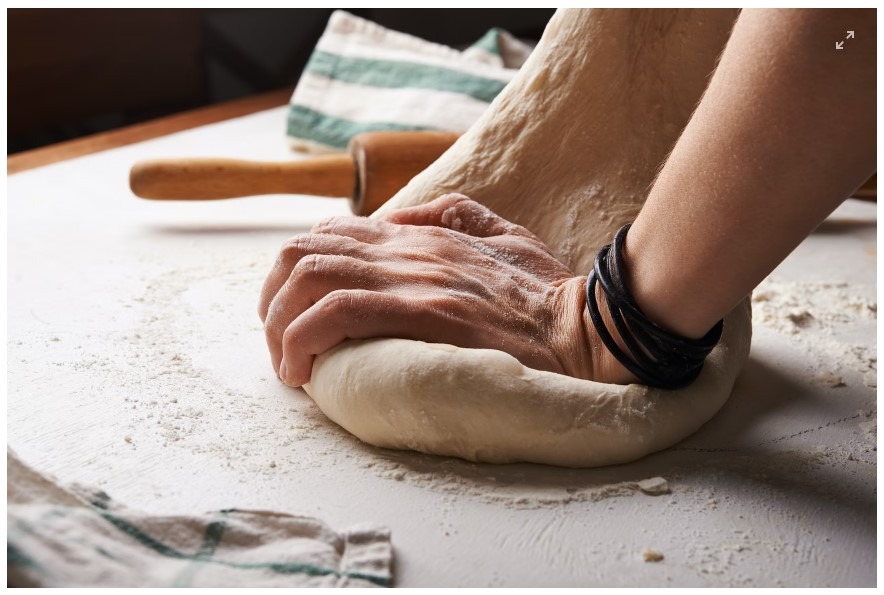For years I’ve been perfecting my homemade pizza. The need arose after I left New York and good pizza options weren’t locally available. Here are eight tips for making better New York-style homemade pie that I’ve developed or learned over the years. My homemade pizza, dough and sauce recipes follow.

Invest in a pizza stone or baking steel. Pizza cooks from the bottom (conduction) and from the top (convection). To simulate a commercial pizza oven you’ll need a pizza stone; more recently baking steel has also become available. These conduct heat via direct contact with the bottom of pizza and ensure a crispy evenly cooked crust. In their experiments, Cook’s Illustrated found that placing the stone towards the top of the oven yields the best results and even pizza cooking. Baking steel is typically more expensive than stones but with care both will literally last forever (hopefully). I’ve had my stone for over 10 years and have steel on order.

Use high-gluten flour. New York-style pizza should be pliable enough to be folded yet sufficiently rigid not to collapse under the weight of the toppings. The outer crust crispy and browned but chewy. High-gluten flour is the key to achieve a balanced crust. It is a specialty ingredient not available in most grocery stores. I regularly source it from the bulk section at Whole Foods or find it online. High gluten and all-purpose flour require different amounts of water (hydration) and for this reason can’t be substituted one-for-one in dough recipes.
Cold ferment dough. Cold fermentation serves two purposes. Refrigeration slows down yeast’s activity causing the fermentation to occur over days rather than hours. This allows for breakdown of complex proteins and sugar and helps develop gluten structure. The result is a superior texture and flavor to baked crust. The optimal time for cold fermentation is 3-5 days. For more about cold fermentation read Tom Lehmann.
Learn how to shape dough. Whether you call it pulling, shaping, stretching or tossing, learning to shape pizza dough should be on your list of things to do if you’re serious about making pizza at home. Achieving a thin interior and thick exterior crust isn’t possible using a rolling pin. There are a number of techniques to shape pizza dough. Learn by watching videos online or read my tutorial below. Don’t be intimated into thinking you need to toss dough up in the air. While it seems cool, this step isn’t necessary. I always ferment dough in a round bowl and take care to preserve the round shape when removing it. Forming a round pizza is much easier when starting with a round dough ball.

A. Remove the dough from the bowl and transfer it to a floured surface taking care to persevere it’s round shape. B. Press the dough with your fingers working from the inside out, keeping the circular shape. Be sure to leave a large outer rim. C. Continue pressing until the dough is completely flat and there is a 1 to 1 1/2 inch outer rim. D. Using one hand along the outside as a guide, press the inner aspect of the dough rim with your opposite hand until it is about an even 3/4 inch thick, rotating the dough as you work. E & F. Stretch the inner flat portion by gently pulling the dough apart with your hands and rotating as you stretch. This should be a side to side motion with finger tips positioned along the outer crust, not an inside out stretch which will result in too thin a center. Stretch the pizza to 15 inches in diameter.
Skip cooking the sauce. I always make sauce. It’s simple, cost effective and tastes better than jarred products. Canned tomatoes are already cooked during canning and additional time simmering on the stove doesn’t impact the flavor significantly. Instead, sauté onions and garlic separately and combine these with canned tomatoes and herbs. It seems obvious but using good quality tomatoes will lead to the best tasting sauce. I prefer San Marzano but these are often pricey. Instead, Cento Italian-Style tomatoes taste similar at a fraction of the cost.

Don’t skimp on the cheese. Pre-shredded, low-fat, bagged cheeses should be avoided. The consistency of melted low-fat cheese can be off-putting and almost plastic-like on pizza. Instead, opt for a block of whole-milk mozzarella and shred it yourself. Fat equals flavor, not only when it comes to meat but pizza too. When cooked, cheese should have some brown bubbles. There’s nothing worse than a pizza with a thick congealed glob of undercooked cheese!
Cook with parchment paper. Transferring an uncooked pizza from a pizza peel to the oven can be a tricky proposition, especially if you’re transferring a 15 inch pizza to a same-sized stone. Prior to using parchment I had a few poor transitions which led to cheese and sauce falling onto the oven floor. Let’s just say it didn’t smell great. Parchment paper makes the transition easy and also cuts down on the mess from excess flour. Save and reusing parchment cuts down on cost.
The temperature of ingredients matters. The temperature of the ingredients can affect how evenly pizza cooks. The best results occur when the dough is room temperature, but sauce and cheese are cold. This will allow the crust sufficient time to brown without cheese being overcooked. Adding warm sauce to an uncooked pizza will cause the cheese overcook before the crust is ready.

While making homemade pizza can seem like a daunting task, with some practice, you’ll on your way to being a pizzailo.
Homemade Pizza
2-4 servings
5 minutes
12 minutes
17 minutes
Enjoy New York-style pizza at home with this recipe using a high-gluten flour based dough and a pizza stone to simulate a commercial pizza oven.
Autor: David Moser / Recipe type: Main Course / Cusine: Italian
Ingredients
- 1 pizza dough ball (recipe below)
- flour for dusting the working surface and dough
- 1 fifteen inch diameter piece of parchment paper
- 1 tablespoon olive oil
- 6 ounces tomato sauce (recipe below)
- 8 to 9 ounces shredded whole milk mozzarella cheese
Instructions
Preheat the oven
- Preheat the oven to 500 degrees with the pizza stone atop the rack in the second position from the top for one hour.
Prep the dough
- Thirty minutes before baking remove the dough from the refrigerator. About 10 minutes before baking shape the pizza. Place the dough on a floured surface taking care to persevere it’s round shape and sprinkle some additional flour on top. Press the dough with your fingers working from the inside out, keeping the circular shape. Be sure to leave a large outer rim of dough. Continue pressing until the dough is completely flat and there is a 1 to 1½ inch outer rim. Using one hand along the outside as a guide, gently press the inner aspect of the dough rim with your opposite hand until it is about an even ¾ inch thick, rotating the dough as you work. Stretch the inner flat portion by pulling and stretching the dough apart with your hands, rotating as you stretch. This should be a side to side motion with finger tips positioned along the outer crust, not an inside out stretch which will result in too thin a center. Stretch the pizza to 15 inches in diameter. Transfer the dough onto the parchment paper, and then atop the pizza peel. Brush the outer crust with olive oil. See my photo tutorial for pictures.
Top the pizza
- Ladle 6 ounces of pizza sauce onto the center of the dough. Spread outwardly in concentric circles until the sauce is evenly spread and it reaches the outer crust.
- Sprinkle the cheese evenly over the sauce.
Bake the pizza
- Carefully slide the pizza onto the pizza stone. Bake for 10-12 minutes until the crust is browned and the cheese bubbly, rotating once midway through cooking. Remove the pizza and let it rest for 5 minutes before slicing and serving.
Notes
Special equipment: pizza stone, pizza peel
Homemade Pizza Sauce

5 (6 ounce portions)
8 minutes
8 minutes
Canned tomatoes have already been cooked so additional time on the stove top isn’t necessary. While San Marzano tomatoes are the best product the cost is also substantially higher. My favorite brand is Cento Italian-style peeled tomatoes which tastes similar to San Marzano but at a fraction of the cost. The sauce can be made a few days in advance or portioned and frozen for later use.
Autor: David Moser / Recipe type: Condiment, Sauce / Cusine: Italian
Ingredients
- 1 tablespoon olive oil or vegetable oil
- ¾ cup (6 ounces) chopped onion
- 4 teaspoons minced garlic (2-3 cloves)
- One 28 ounce can whole peeled tomatoes (Cento Italian-style preferred)
- ½ teaspoon Kosher salt (Morton’s)
- 1 teaspoon dried oregano
- A pinch of red pepper flakes (optional)
Instructions
- Heat a 3½ quart saucepan over medium-low heat. Add the oil and onions and cook for 5 to 6 minutes until the onions are softened and translucent (turn the heat down if the onions begin to brown). Add the garlic and cook for an additional 1 to 2 minutes.Turn off the heat and let the mixture cool. Combine all the ingredients and process with a hand blender until the sauce is smooth without any chunks of tomatoes or onion. A regular blender or food processor can be used instead.
Pizza Dough

10 minutes
10 minutes
High-gluten flour is the key to a crisp but chewy crust that New York-style pizza is known for. Ideally the ingredients for this recipe should be weighed. If you don’t have a scale, I have approximated volumes.
Autor: David Moser
Ingredients
- 167 grams (175 mls or just short of ¾ cups by volume) warm water (100 degrees Fahrenheit)
- 2 grams (1/2 teaspoon) active dry yeast
- 5 grams (1 teaspoon) honey
- 4 grams (1 teaspoon) olive oil + 1 teaspoon for oiling the bowl
- 265 grams (2 cups plus 4 teaspoons by volume) high-gluten flour
- 5 grams (1/2 teaspoon) Morton’s kosher salt
Instructions
Prep the wet ingredients
- In a bowl whisk together the water, yeast, honey and 1 teaspoon oil. Let the mixture sit for 5-10 minutes until the yeast becomes active and begins to bubble.
Mix and knead the dough
- To a standing mixer fitted with a dough hook add the flour and salt. Turn the machine on to medium speed and pour in the wet ingredients. After the dough comes together knead for an additional 5 minutes.
Ferment the dough
- Coat the bottom of a large bowl with olive oil and add the dough. Cover with plastic wrap and refrigerate for 3 to 5 days.
